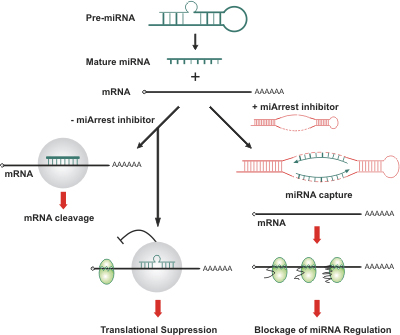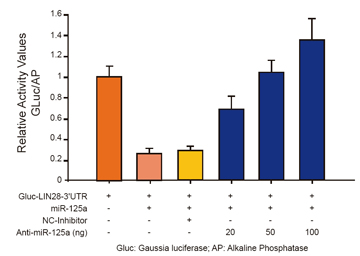Starting from $325
Introduction
Table 1. Comparison of vector-based inhibitors vs. synthesized miRNA inhibitors

| microRNA (miRNA) inhibitors block miRNA regulation of target gene expression. They are designed and optimized for miRNA loss of function study. GeneCopoeia offers miArrest miRNA inhibitors as vector-based expression clones or synthetic oligonucleotides. | |
| Vector-based expression clones are available in lentiviral and non-viral vectors. miRNA inhibitor clones bind specifically to their target miRNAs allowing transient as well as stable suppression of the target gene. The choice of H1 or U6 promoter allows constitutive expression of inhibitors in virtually all types of mammalian cells. |
Advantages
Full coverage
- All known human, mouse and rat miRNAs in the miRBase covered.
Flexible delivery systems
- Lentiviral vectors allow efficient transduction and stable integration into the host genome of non-dividing and difficult to transfect cells target cells
- Non-viral vectors allow either transient or stable transfection
Advanced and reliable design
- Expression cassettes have been designed using a proprietary algorithm and tested rigorously by carefully designed experiments
Superior performance
- Superior potency, long lasting inhibition and extremely low cell toxicity compared to other chemically synthesized miRNA inhibitors (see table 1)
- Choices of H1 or U6 promoter allow constitutive expression of inhibitors in virtually all mammalian cell types.
High-throughput compatible
- Quick and easy assay format
- High sample number compatible
Figure 1. Data showing the effect of miArrest miRNA inhibitor clone in a dose-dependent manner A miR-125a inhibitor expression plasmid (GeneCopoeia HmiR-AN0094-AM01) was transfected into HEK 293 cells with 1) a miR-125a precursor expression plasmid (GeneCopoeia HmiR0309-MR03) and 2) a miRNA target sequence expression clone expressing LIN28, a known target gene for miR-125a (GeneCopoeia HmiT019205-MT02: 3′-UTR sequence of LIN28 in gaussia luciferase-alkaline phosphatase dual reporter expression vector). Both the GLuc activity and an internal control AP activity were determined 24 hours post-transfection. The activity ratio of GLuc to AP was set to 1 for the single transfection sample with LIN28 3′-UTR target sequence expression clone (left-most bar), against which the activities of other samples were normalized. The result shows that mir-125a suppressed the luciferase activity from the Gluc-LIN28-3′-UTR clone by more than 70% (Bar 2 from left). This suppression effect was blocked by the introduction of varying amount of miArrest™ inhibitor clone against miR-125a in a dose-dependent manner. At the highest dose, the reporter GLuc activity is higher than the control (right-most bar). This could be attributed to the fact that this vector-based inhibitor may have blocked the regulatory effect of endogenous miR-125a, which would result in increased translational activity of GLuc-LIN28-3′-UTR transcript.
| Vector-Based Inhibitors | Synthetic 2′-OMe Inhibitors | LNA Inhibitors | |
|---|---|---|---|
| Inhibition | +++++ | ++ | ++ |
| Specificity | +++++ | +++ | +++ |
| Stability | +++++ | + | +++ |
| Durability | Long term | Transient | Transient |
| Cell Toxicity | – | – | + |
| Delivery to resting and hard-to-transfect cells | +++++ | – | – |

Figure 2. Simplified mechanism of action for vector-based miRNA inhibitors
miRNA inhibitor constructs bind specifically to their target miRNA upon transduction into cells. The post-transcriptional processing causes formation of an entrapping structure that attracts and binds to two molecules of the intended miRNA.
This in turn prevents the binding of endogenous miRNA to target mRNA, thus inhibiting the effect of miRNA on target gene and facilitating enhanced target gene expression (figure 3).
A unique vector design ensures maximum inhibition with specificity and long-lasting stability while keeping off-target effects to a minimum.



